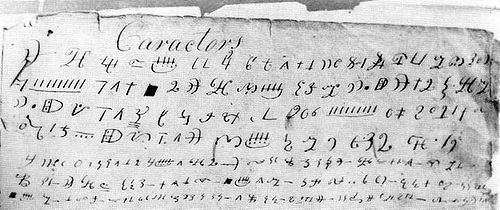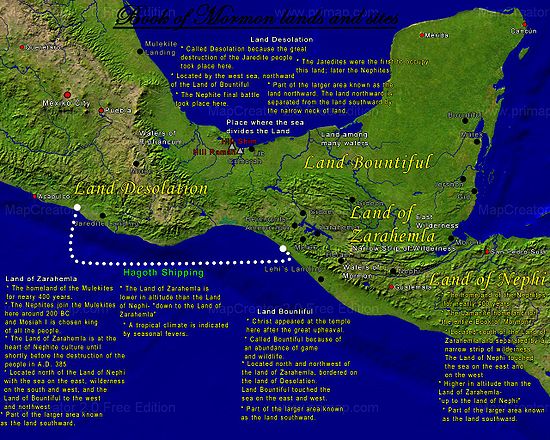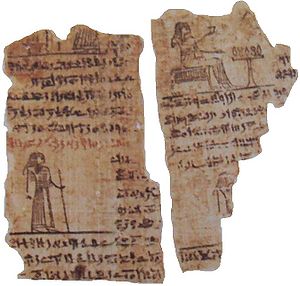
Criticism of the Book of Mormon
Encyclopedia
The Book of Mormon
, published in 1830 by American religious leader Joseph Smith
(who claimed it to be a translation of an ancient Native American record), is the subject of criticism relating to its origin, text, and historical accuracy.
, and that God gave him the power to translate it into English. Critics note that there is no physical proof of the existence of golden plates; Smith said that the angel Moroni reclaimed the plates once he had completed the translation. Smith acquired affidavit
s from 11 men, known as the Book of Mormon witnesses
, claiming that they had been shown the plates; their testimony is typically published at the beginning of the Book of Mormon. While none of these men ever retracted their statement, critics nevertheless discount these testimonies for varying reasons, primarily because most of these men were closely interrelated.
Critics deny that the Book of Mormon is of ancient origin. They assert that portions of the Book of Mormon were plagiarized from modern publications of Smith's time, including the King James Bible, The Wonders of Nature
, View of the Hebrews, and an unpublished manuscript
written by Solomon Spalding
. Critics have varying theories about the true authorship of the Book of Mormon, but most conclude that Smith fabricated it himself, or possibly with the aid of Oliver Cowdery
.
 Critics view the language patterns, phrases, and names in the Book of Mormon as evidence that it is not authentic.
Critics view the language patterns, phrases, and names in the Book of Mormon as evidence that it is not authentic.
Joseph Smith claimed that he translated the Book of Mormon from a language called Reformed Egyptian
. Archaeologists and Egyptologists, however, have found no evidence that this language ever existed. Furthermore, the Book of Mormon implies that at least some native Americans came from the Jerusalem area; however, Native American linguistic specialists
have not found any native American language that appears to be related to languages of the ancient Near East.
Critics claim that language patterns in the Book of Mormon indicate that it is merely a repetition of rhetorical patterns found in the Old Testament. They point out that the Book of Mormon contains many words and phrases that are not consistent with the time frame or location of the stories included in the book. Supporters of the Book of Mormon note its repeated use of chiasmus
—a figure of speech utilizing inverted parallelism—and claim it is evidence to support the book's ancient origin. Critics argue that while chiasmus appears in short form within ancient classical works of Rome, the complex stylization of these passages found in the Book of Mormon is more similar to that found in works of the Renaissance
and into the 18th/19th centuries. There is no evidence of chiasmus in the ancient literature of the Near East or within the known rhetoric of ancient Native American cultures.
Some critics theorize that Smith derived the account of the golden plates from treasure-hunting stories of William Kidd
. Critics base this theory on the similarity of the names from Smith's account—Moroni and Cumorah—to the location Moroni, Comoros
, related to Kidd's hunt for treasure. Apologists argue that it was unlikely that Smith had access to this material.
Apologists offer varying views on these anachronisms, typically countering them in one of two ways. One claim is that archaeological evidence may exist that has not yet been found. Another is that Joseph Smith used English words in a generic way, sometimes referring to an item other than that which the direct English word would imply.
 Critics point out that there are many inconsistencies and implausibilities in the story of the Israelites coming from the Mid-East to the Americas, and in the geographical descriptions of the lands in the Americas in which the stories take place.
Critics point out that there are many inconsistencies and implausibilities in the story of the Israelites coming from the Mid-East to the Americas, and in the geographical descriptions of the lands in the Americas in which the stories take place.
s to conclude that Native American genes are of Asian, not Middle Eastern in origin. Apologists argue that the Middle Eastern genes in Native Americans may have been diluted beyond what can now be detected; there is currently no way to verify this claim with genetic evidence.
 Critics reject the belief that the Book of Mormon is of divine origin; they discredit the book's divine origin by discrediting Joseph Smith. Critics point out that Joseph Smith also translated the Book of Abraham
Critics reject the belief that the Book of Mormon is of divine origin; they discredit the book's divine origin by discrediting Joseph Smith. Critics point out that Joseph Smith also translated the Book of Abraham
. Unlike the Book of Mormon, fragments of the documents from which Smith translated the Book of Abraham are available for inspection; Egyptologists find no resemblance between the original text and Smith's translation, casting doubt on Smith's claimed divine gift of translation.
Critics also discredit the divine origin of the Book of Mormon by noting the numerous revisions that have been made to the text.
Though most changes are small spelling and grammar corrections, critics claim that even these are significant in light of Smith's claims of divine inspiration. Critics assert that some of these changes were systematic attempts to hide the book's flaws.
Book of Mormon
The Book of Mormon is a sacred text of the Latter Day Saint movement that adherents believe contains writings of ancient prophets who lived on the American continent from approximately 2600 BC to AD 421. It was first published in March 1830 by Joseph Smith, Jr...
, published in 1830 by American religious leader Joseph Smith
Joseph Smith
Joseph Smith was founder of what later became known as the Latter Day Saint movement or Mormons.Joseph Smith may also refer to:-Latter Day Saints:* Joseph Smith, Sr. , father of Joseph Smith...
(who claimed it to be a translation of an ancient Native American record), is the subject of criticism relating to its origin, text, and historical accuracy.
Ancient origin
Critics reject Smith's explanation of the origin of the Book of Mormon. Joseph Smith said that the Book of Mormon was originally an ancient native-American record written on golden platesGolden Plates
According to Latter Day Saint belief, the golden plates are the source from which Joseph Smith, Jr. translated the Book of Mormon, a sacred text of the faith...
, and that God gave him the power to translate it into English. Critics note that there is no physical proof of the existence of golden plates; Smith said that the angel Moroni reclaimed the plates once he had completed the translation. Smith acquired affidavit
Affidavit
An affidavit is a written sworn statement of fact voluntarily made by an affiant or deponent under an oath or affirmation administered by a person authorized to do so by law. Such statement is witnessed as to the authenticity of the affiant's signature by a taker of oaths, such as a notary public...
s from 11 men, known as the Book of Mormon witnesses
Book of Mormon witnesses
The Book of Mormon witnesses are a group of contemporaries of Joseph Smith, Jr. who said they saw the golden plates from which Smith said he translated the Book of Mormon...
, claiming that they had been shown the plates; their testimony is typically published at the beginning of the Book of Mormon. While none of these men ever retracted their statement, critics nevertheless discount these testimonies for varying reasons, primarily because most of these men were closely interrelated.
Critics deny that the Book of Mormon is of ancient origin. They assert that portions of the Book of Mormon were plagiarized from modern publications of Smith's time, including the King James Bible, The Wonders of Nature
The Wonders of Nature
The Wonders of Nature is a book by Josiah Priest that was published in 1826.Some critics of Mormonism, such as Jerald and Sandra Tanner and Richard Arbanes, consider The Wonders of Nature to be a relevant work for its historical connection to Mormonism. David Persuitte concluded that there were a...
, View of the Hebrews, and an unpublished manuscript
Spalding–Rigdon theory of Book of Mormon authorship
The Spalding–Rigdon theory of Book of Mormon authorship is the theory that the Book of Mormon was plagiarized in part from an unpublished manuscript written by Solomon Spalding. This theory first appeared in print in the book Mormonism Unvailed, published in 1834 by E.D. Howe...
written by Solomon Spalding
Solomon Spalding
Solomon Spalding was the author of the Manuscript Story, a work of fiction about the lost civilization of the mound builders of North America...
. Critics have varying theories about the true authorship of the Book of Mormon, but most conclude that Smith fabricated it himself, or possibly with the aid of Oliver Cowdery
Oliver Cowdery
Oliver H. P. Cowdery was, with Joseph Smith, Jr., an important participant in the formative period of the Latter Day Saint movement between 1829 and 1836, becoming one of the Three Witnesses of the Book of Mormon's golden plates, one of the first Latter Day Saint apostles, and the Second Elder of...
.
Text and language

Joseph Smith claimed that he translated the Book of Mormon from a language called Reformed Egyptian
Reformed Egyptian
According to the Book of Mormon, that scripture of the Latter Day Saint movement was originally written in reformed Egyptian characters on plates of "ore" by prophets living in the Western Hemisphere from perhaps as early as 2600 BC until as late as AD 421. Joseph Smith, Jr., the founder of the...
. Archaeologists and Egyptologists, however, have found no evidence that this language ever existed. Furthermore, the Book of Mormon implies that at least some native Americans came from the Jerusalem area; however, Native American linguistic specialists
Linguistics
Linguistics is the scientific study of human language. Linguistics can be broadly broken into three categories or subfields of study: language form, language meaning, and language in context....
have not found any native American language that appears to be related to languages of the ancient Near East.
Critics claim that language patterns in the Book of Mormon indicate that it is merely a repetition of rhetorical patterns found in the Old Testament. They point out that the Book of Mormon contains many words and phrases that are not consistent with the time frame or location of the stories included in the book. Supporters of the Book of Mormon note its repeated use of chiasmus
Chiasmus
In rhetoric, chiasmus is the figure of speech in which two or more clauses are related to each other through a reversal of structures in order to make a larger point; that is, the clauses display inverted parallelism...
—a figure of speech utilizing inverted parallelism—and claim it is evidence to support the book's ancient origin. Critics argue that while chiasmus appears in short form within ancient classical works of Rome, the complex stylization of these passages found in the Book of Mormon is more similar to that found in works of the Renaissance
Renaissance
The Renaissance was a cultural movement that spanned roughly the 14th to the 17th century, beginning in Italy in the Late Middle Ages and later spreading to the rest of Europe. The term is also used more loosely to refer to the historical era, but since the changes of the Renaissance were not...
and into the 18th/19th centuries. There is no evidence of chiasmus in the ancient literature of the Near East or within the known rhetoric of ancient Native American cultures.
Some critics theorize that Smith derived the account of the golden plates from treasure-hunting stories of William Kidd
William Kidd
William "Captain" Kidd was a Scottish sailor remembered for his trial and execution for piracy after returning from a voyage to the Indian Ocean. Some modern historians deem his piratical reputation unjust, as there is evidence that Kidd acted only as a privateer...
. Critics base this theory on the similarity of the names from Smith's account—Moroni and Cumorah—to the location Moroni, Comoros
Moroni, Comoros
-References:...
, related to Kidd's hunt for treasure. Apologists argue that it was unlikely that Smith had access to this material.
Historical accuracy
Critics discredit the historical accuracy of the Book of Mormon. They note various issues, including anachronisms, geographical inconsistencies, and lack of genetic evidence.Anachronisms
Critics point out that the Book of Mormon contains references to various plants and animals (horses, swine, etc) that did not exist in the Americas at the time of the story. Critics also point out that the Book of Mormon contains references to various technologies (chariots, steel, etc) that did not exist in the Americas at the time of the story.Apologists offer varying views on these anachronisms, typically countering them in one of two ways. One claim is that archaeological evidence may exist that has not yet been found. Another is that Joseph Smith used English words in a generic way, sometimes referring to an item other than that which the direct English word would imply.
Geography

Native Americans and genetics
The Book of Mormon suggests that the Native Americans are descended from people who came to the Americas by boat from the Middle East. However, scientists have used techniques involving genetic markerGenetic marker
A genetic marker is a gene or DNA sequence with a known location on a chromosome that can be used to identify cells, individuals or species. It can be described as a variation that can be observed...
s to conclude that Native American genes are of Asian, not Middle Eastern in origin. Apologists argue that the Middle Eastern genes in Native Americans may have been diluted beyond what can now be detected; there is currently no way to verify this claim with genetic evidence.
Divine nature of the book

Book of Abraham
The Book of Abraham is a 1835 work by Joseph Smith, Jr. that he said was based on Egyptian papyri purchased from a traveling mummy exhibition. According to Smith, the book was "a translation of some ancient records....purporting to be the writings of Abraham, while he was in Egypt, called the Book...
. Unlike the Book of Mormon, fragments of the documents from which Smith translated the Book of Abraham are available for inspection; Egyptologists find no resemblance between the original text and Smith's translation, casting doubt on Smith's claimed divine gift of translation.
Critics also discredit the divine origin of the Book of Mormon by noting the numerous revisions that have been made to the text.
Though most changes are small spelling and grammar corrections, critics claim that even these are significant in light of Smith's claims of divine inspiration. Critics assert that some of these changes were systematic attempts to hide the book's flaws.
See also
- Criticism of Mormon sacred textsCriticism of Mormon sacred textsThe Latter Day Saints believe that the Book of Mormon, the Pearl of Great Price and the Doctrine and Covenants are sacred texts with the same divine authority as the Bible.-Origin:...
- Criticism of the Church of Jesus Christ of Latter-day SaintsCriticism of The Church of Jesus Christ of Latter-day SaintsThe Church of Jesus Christ of Latter-day Saints has been the subject of criticism since it was founded by American religious leader Joseph Smith, Jr. in 1830. Historically, no issue brought greater criticism on the church than that of its practice of plural marriage, which it officially abandoned...
- Criticism of Mormonism
- Book of Mormon anachronismsBook of Mormon anachronismsThere are a variety of words and phrases in the Book of Mormon that are considered anachronistic as their existence in the text of the Book of Mormon is at odds with known linguistic patterns, archaeological findings, or known historical events....

